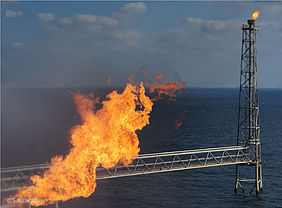The World Bank's Global Gas Flaring Reduction Partnership and the U.S. The Energy Information Administration published several papers throughout 2020 presenting statistics and technological advances in the area of associated petroleum gas utilization. This topic is of importance as methane is the most prevalent active greenhouse gas, with current levels of emissions dangerously high. The combustion of methane in controlled volumes is a necessary operation in order to ensure the safety of various technological processes, however harmful gas flares are occurring in large quantities, particularly in the process of oil extraction. This leads to significant CO2 emissions and an irretrievable loss of valuable raw materials for the production of useful products. This is due to the serious difficulties of associated petroleum gas utilization, since its transportation to gas processing plants from distant oil fields requires the construction of additional pipelines and gas treatment facilities. These measures can make many oil production projects unprofitable. On-site conversion of associated petroleum gas to liquid fuel or electricity also requires expensive and complex equipment. Therefore, associated petroleum gas is most often re-injected into oil reservoirs after additional treatment. In a number of cases, this makes it possible to increase reservoir pressure or reduce oil viscosity and, as a result, increase oil production. However, only a fully-fledged useful utilization of associated petroleum gas via modern technologies can simultaneously increase the oil production efficiency, significantly reduce its energy intensity and produce additional types of gas processing products in compliance with environmental standards.
Findings from the Global Gas Flaring Tracker Report (GGFR) based on data from NOAA, Colorado School of Mines and other sources, conclude that the organizational and technological problems of utilizing associated petroleum gas have not been adequately resolved and require solutions.
For example, the level of associated gas flaring in the world, with accompanying CO2 emissions, remains very high. Despite the fact that over the past twenty-four years, global oil production has increased by more than 35%, and the volume of associated gas flaring, on the contrary, has decreased by almost 10%, 150 billion m3 of associated petroleum gas is still being flared annually. This particularly applies to Russia, Iraq, Iran and the United States.
In the past five years, according to the above-mentioned sources, Russia has remained the leader in associated gas flaring, with volumes growing continuously over the past three years. Associated gas flaring remains at a high level in Iraq and Iran, although in Iran levels dropped significantly between 2017 and 2019. During the last year this indicator has increased by over 1.3 billion cubic meters in Venezuela, by almost 0.6 bcm in Mexico, by more than 0.5 bcm in Australia, by 0.45 bcm in Libya, by 0.39 bcm in Nigeria, and by 0.33 bcm in Algeria. As a result, in 2019, the total combustion volume increased by 5.0 billion cubic meters. However, the most significant increase in associated petroleum gas flaring occurred in the United States, where it almost doubled between 2016 and 2019 due to the overall increase in oil production. According to the U.S. Energy Information Administration associated petroleum gas production accounted for 12% of the country's total natural gas production in 2018. Since 2010, growth has taken place in all major oil formations, especially in Permian. In addition, the U.S. The Energy Information Administration highlights a nearly 2-fold increase in Associated-Dissolved Natural Gas Proved Reserves, Wet After Lease Separation over a past few years: 69,117 billion cubic feet in 2014 compared to 121,856 billion cubic feet in 2019.
According to estimates by NOAA, Colorado School of Mines, GGFR in 2019, the total volume of associated gas flaring in the world amounted to 150 billion cubic meters: Russia accounted for 15.5%; Iraq for 12%; USA for 11.5%; Iran for 9.2%; Venezuela for 6.3%; and Algeria for 6.2%. When considering the ratio of flaring gas volumes to oil production, according to The World Bank's 2019 Global Gas Flaring Tracker, the largest oil producers show relatively moderate values: the USA – 3.87 m3/b and Russia – 5.86 m3/b. Moreover, Saudi Arabia has one of the lowest indicators in the world – 0.59 m3/b. For most other oil exporting countries, these values are in the range of 7-13 m3/b. Higher values are shown by Venezuela, with around 30 m3/b, Algeria with a little over 20 m3/b and Turkmenistan with around 17.5 m3/b.
One of the promising options for the full conversion of associated petroleum gas is gas-to-liquid (GTL) technology, particularly in its small-sized configuration (mini-GTL), which allows for wide possible application in the field.
The most important event of 2019 in the field of associated gas was the opening of a Gas to Gasoline plant using Haldor Topsoe's TIGAS technology near the capital of Turkmenistan, Ashgabat. According to GGFR, the plant can process 175,000 Nm3/h of associated petroleum gas into 15,500 bpd of high octane gasoline. This is the first commercial project implemented using TIGAS technology. Haldor Topsoe plans to launch similar plants in Turkmenistan, the United States and Russia. The authors also reported that several GTL plants are under construction, including Rocky Mountain GTL in Alberta, Canada, with the capacity to produce 500 bpd from natural gas and NGLs, and a number of plants in Texas, USA run by Primus Green Energy and Greyrock Energy.
Among newly developed technologies, GGFR note HiiROC Ltd’s (UK) plasma technology, which disassociates methane and other hydrocarbons into hydrogen and black carbon; the modular micro-GTL units project by Galores B.V. (the Netherlands); and Dason's “Short Contact Time Oxidation Reactor” technology for direct oxidation of methane to syngas.
